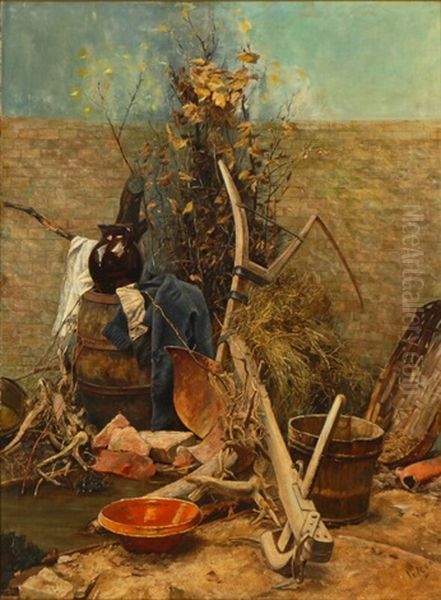
Anna Peters stands as a significant figure in German art history, a painter whose life and work bridged the traditions of her Dutch heritage with the artistic currents of her time in Germany. Born in 1843 and passing away in 1926, she carved out a successful career, primarily known for her exquisite flower paintings and evocative landscapes, navigating the challenges faced by female artists in the 19th century.
Her existence is well-documented, confirming her as a real historical personage. Evidence points to her origins within a family deeply rooted in the arts, a factor that undoubtedly shaped her path. She became particularly celebrated for her floral still lifes, yet her oeuvre also encompassed the quiet beauty of the countryside, reflecting an artistic sensibility attuned to both nature's detail and its broader vistas.
Early Life and Artistic Formation
Anna Peters was born in Mannheim, Germany, in 1843. Her parentage immediately placed her within an artistic milieu. Her father was the notable Dutch landscape painter Pieter Francis Peters, and her mother, Heinrika Mali (referred to in some sources as Heilena Marli), also hailed from an artistic background. This familial connection to the Netherlands would remain a subtle but persistent thread in her artistic identity.
A pivotal moment in her early life occurred in 1845 when her maternal uncle, Christian Mali, came to live with the Peters family. Christian, himself an artist, took on the significant role of overseeing Anna's artistic education. Growing up alongside her sisters, Ida and Petra, Anna was immersed in an environment where art was not just appreciated but actively practiced and taught.
This upbringing provided Anna with a robust foundation in artistic techniques and sensibilities. The household was essentially a cradle of creativity, fostering the talents of the Peters daughters. This early exposure and dedicated tutelage under her uncle were crucial in developing her skills and confidence as a painter from a young age.
Artistic Development and Style

By 1868, Anna Peters had already gained recognition, primarily identified as a painter specializing in flowers and birds (a Blumenmalerin). This initial focus aligned with subjects often deemed suitable for female artists of the era, yet Peters would demonstrate a capacity to transcend these expectations throughout her career.
Her artistic style was not static; it evolved considerably over her lifetime. Starting from a foundation perhaps rooted in the Academic Romanticism prevalent during her formative years, her approach gradually loosened, embracing a freer application of paint and a brighter palette. This trajectory moved her work towards the sensibilities of Impressionism, although she may not have fully adopted its tenets.
A remarkable aspect of her work, particularly noted in her flower paintings, was her ability to achieve variety and freshness. She skillfully avoided mere repetition through inventive compositional arrangements and a keen eye for detail, demonstrating considerable creativity within her chosen genre. This dedication to innovation marked her as an artist of substance.
Furthermore, her connection to her Dutch heritage is often cited. Her work is seen as inheriting the qualities of tranquility and harmony associated with the Dutch "Little Masters" (Kleinmeister) of the Golden Age, particularly evident in the quiet dignity of her still lifes and the peaceful atmosphere of her landscapes.
Themes and Subjects
Flowers remained a central theme throughout Anna Peters' career. She depicted them with meticulous attention to detail, capturing their delicate textures and vibrant colours. These works ranged from simple bouquets to more elaborate arrangements, often set against neutral backgrounds that emphasized the blooms themselves.
However, Peters was also a dedicated landscape painter. Her travels provided rich inspiration for this aspect of her work. She journeyed to various picturesque locations, including Florence, Rome, and Lugano, capturing the distinct light and scenery of Italy and Switzerland. These excursions broadened her artistic horizons and infused her landscapes with diverse geographical flavours.
She also painted scenes closer to home. Works depicting the area around her birthplace, Mannheim, exist, such as the oil painting titled "Anna Peters – Umkreis Mannheim" (Anna Peters – Around Mannheim). She also found inspiration in her Dutch ancestral homeland, creating works during visits to Nijmegen, and later, during regular painting trips to Köngen, near Esslingen, from 1894 onwards.
Beyond flowers and landscapes, Peters occasionally explored other subjects. Some accounts mention her creating children's portraits or scenes (Kinderbildnisse), suggesting a broader range of interests. A specific work mentioned in auction records, "Garden tools and branches by a wall," indicates an interest in rustic still life elements as well.
Career and Recognition
Anna Peters pursued a professional career as an artist, exhibiting her work widely and gaining considerable recognition. Her paintings were shown in major art centres, including Berlin, Munich, Dresden, and even internationally in Paris. This exposure placed her work before a broad audience and situated her within the contemporary art discourse.
A significant milestone in her career was her acceptance into the prestigious Berlin Association of Artists (Verein der Berliner Künstlerinnen) in 1880. Membership in such organizations was crucial for professional validation, networking, and exhibition opportunities, particularly for women artists who often faced barriers to entry in the male-dominated art establishment.
Importantly, Anna Peters was able to support herself through the sale of her artwork. This economic independence was a notable achievement for a woman in the 19th century, especially in the competitive field of professional art. It speaks to both her talent and her determination to pursue her vocation seriously.
Her participation in exhibitions and her membership in artistic societies underscore her active engagement with the art world of her time. She was not an isolated figure but a participating member of the artistic community, contributing her unique vision and skill.
The Peters Family Artists
The artistic environment of the Peters family cannot be overstated as a factor in Anna's life and career. Her father, Pieter Francis Peters (1818-1903), was an established landscape painter whose Dutch roots likely influenced Anna's own affinity for landscape and perhaps her stylistic connection to Dutch traditions. His success provided a model and likely facilitated her entry into the art world.
Her uncle, Christian Mali (1832-1906), played the crucial role of mentor and educator. His guidance during her formative years was instrumental in shaping her technical skills and artistic direction. The close relationship between the Peters and Mali families created a supportive network.
Anna was not the only artist among her siblings. Her sister, Petronella Peters (1848-1924), also achieved success as a painter, specializing in portraits and landscapes. The sisters, along with potentially Ida, lived and worked together, particularly later in life. Sources mention the family residing in Stuttgart-Sonnenberg, where they maintained studios.
This shared artistic life within the family provided mutual support and likely fostered a stimulating environment for creative development. The Peters family, including Anna, her father, uncle, and sister, represented a notable artistic dynasty, contributing significantly to the art scene, particularly in Southern Germany.
Navigating the Art World as a Woman
The context of Anna Peters' career must include an understanding of the societal constraints placed upon women artists during the 19th century. While opportunities were slowly opening, significant prejudice and limitations remained. Women were often steered towards specific genres, like flower painting or portraiture, considered more appropriate for their gender.
Anna Peters operated within this context, initially gaining fame as a flower painter. However, her work demonstrates an ambition that extended beyond these confines. Her dedication to landscape painting and her travels for artistic purposes show a desire for broader experience and subject matter, akin to her male contemporaries.
Her ability to earn a living through her art and gain membership in professional associations like the Berlin Association of Artists marks her as a successful professional who navigated these challenges effectively. She asserted her artistic independence through the quality and consistency of her work and her active participation in the exhibition circuit.
While perhaps not overtly rebellious, her career path demonstrates a quiet determination to be recognized on her own merits as an artist, irrespective of gender. She pursued her vision, developed her style, and achieved a level of recognition that affirmed her place in the art world.
Context and Connections
Anna Peters' artistic journey unfolded during a period of significant change in European art. While her early work aligned with the lingering influences of Romanticism and Biedermeier sensibilities, her later stylistic evolution towards a freer, more light-filled approach reflects the broader shifts towards Realism and Impressionism occurring across Europe.
While detailed records of direct collaborations beyond her immediate family (her father Pieter Francis Peters, uncle Christian Mali, and sister Petronella Peters) are scarce in the provided information, her work existed within a rich artistic landscape. In Munich, where she exhibited, the dominant figures included artists of the Munich Circle like Wilhelm Leibl, known for their realist tendencies.
The movement towards plein-air painting and capturing fleeting effects of light, which her later work approached, was gaining momentum. In Germany, artists like Max Liebermann and Fritz von Uhde were pioneering German Impressionism. Though Peters' style remained distinct, she was working concurrently with these developments.
Given her Dutch heritage and focus on landscape and intimate scenes, one might draw contextual parallels with the contemporary Hague School in the Netherlands. Painters like Anton Mauve or Hendrik Willem Mesdag were similarly exploring atmospheric landscapes and scenes of rural life, albeit with their own distinct national style.
Her exhibitions in Paris placed her work, however briefly, in the epicentre of artistic innovation, where French Realism, championed by artists like Gustave Courbet, had paved the way for the Impressionist revolution led by figures such as Claude Monet. While not an Impressionist herself, Peters was certainly aware of these currents, and her stylistic evolution suggests an openness to contemporary trends.
Legacy
Anna Peters left behind a substantial body of work that continues to be appreciated for its technical skill, sensitivity to nature, and quiet charm. She successfully navigated the professional art world of the 19th century, achieving recognition and supporting herself through her painting during a time when this was a significant challenge for women.
Her artistic legacy lies in her beautiful floral still lifes, which demonstrate mastery of the genre, and in her evocative landscapes that capture the essence of the places she visited and lived in. Her work represents a fascinating blend of her Dutch artistic heritage and her life and career within the German art scene.
The evolution of her style, from more traditional beginnings towards a freer, lighter mode of expression, reflects the broader artistic transitions of her era. She remains an important example of a successful female German painter from the 19th century, whose dedication to her craft resulted in a rich and enduring artistic contribution. Her life and work continue to offer insights into the art world of her time and the specific experiences of women artists within it.